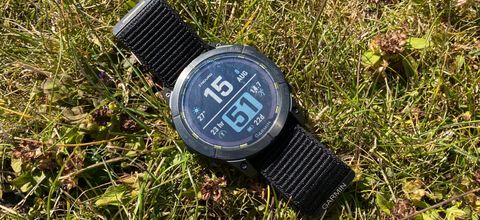Our Verdict
The Garmin Enduro 2 is essentially a Fenix 7X Plus, offering the same excellent features in a watch that lasts even longer on a charge. However, it’s expensive, so only if you need that extra battery life is the investment worthwhile.
For
- Battery life
- Maps and music
- Superior sports tracking
Against
- Better value elsewhere
- Too large/bulky for some
You can trust Coach
The original Garmin Enduro lived up to its name by offering stupendous battery life, but unless you really craved the joy of only charging your watch once a month, it was a hard sell when compared with the best running watches, like the Garmin Fenix 7. That’s because, as I noted in my Garmin Enduro review, it was more expensive but lacked features such as music storage and maps – compromises presumably made to free up room for a bigger battery.
With the Garmin Enduro 2 you no longer have to choose between features and battery life. It’s packed with all of Garmin’s best sports tracking features and now has music and maps, along with the monster battery life. The watch is the new top dog in Garmin’s range – and has a price to match.
Garmin Enduro 2: Price And Availability
The Enduro 2 is available now and costs $1,099.99 in the US and £929.99 in the UK. It is the most expensive sports watch in Garmin’s range (excluding the luxury Marq devices). The price is a big hike on the original Enduro, which was $799.99/£699.99 for the steel version and $899.99/£799.99 for the titanium watch (now available for £549.99 and £619.99 in the UK). The Enduro 2 is also more expensive than the Garmin Epix 2 (from $899.99/£799.99) and Fenix 7 (from $699.99/£599.99).
Recent updates
December 1, 2023: There are now regular sales and deals featuring the Garmin Enduro 2. In our extensive coverage of the best Black Friday Garmin deals in 2023 the best prices we tracked were $799.99 and £799.
Design
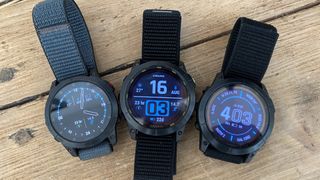
The design of the Enduro 2 is similar to the original Enduro and Fenix 7 range, but to keep things simple there is just one model. This has a titanium bezel and rear cover, and is thicker than the original Enduro at 15.6mm (vs 14.9mm). The case diameter is 51mm and it has a 1.4in (36mm) transflective display, which is now a touchscreen with solar panels around the outside.
On the top of the case is an LED torch that’s twice as bright as the one on the Fenix 7X. The torch has four brightness settings, plus a red-light mode. There are all the key sensors, including an altimeter, barometer and compass, as well as a pulse oximeter to track blood oxygen saturation. The watch is waterproof to 10ATM.
The Enduro 2 has multi-band, multi-GNSS tracking, which uses GPS, Galileo and GLONASS satellite systems simultaneously via two bands, though this max accuracy mode reduces its substantial battery life. It’s a big watch, but sits snugly on the wrist and feels lightweight given its size. I wore the Enduro 2 comfortably 24/7, especially when using the nylon band, which dries quickly after a shower.
Probably the feature that was most missed on the original Enduro was Garmin’s excellent maps and navigation aids, and those have been added to the Enduro 2. The new watch also offers music storage and the ability to link with streaming services like Spotify (if you’re a subscriber) to wirelessly transfer music to the watch. Streaming music from the Enduro 2 to wireless headphones will reduce battery significantly. Garmin quotes 20 hours of battery in all-systems-on GPS mode with music.
The Enduro 2 also debuts a training metric called grade adjusted pace (GAP), which gives you a current pace reading that takes into account the incline you’re on, so it will be slower than your pace on downhills and faster on uphills. It can help you pace yourself over hilly routes, which will naturally appeal to the adventurous ultramarathon crowd.
As you’d hope given the price, the Enduro 2 also picks up the other smart features and training analysis seen on Garmin’s other flagship watches, including Garmin Pay and training readiness. Not every feature was available on the watch before launch, but they are due to arrive in updates this year.
Battery Life
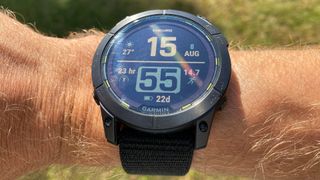
A long battery life is the key feature of the Enduro 2 and the only reason to upgrade to it from a Garmin Fenix 7, though the yellow accents around the screen of the Enduro 2 are an attractive design difference from the Fenix. Garmin suggests the Enduro 2 will last up to 34 days in smartwatch mode (46 days with solar) or 110 hours of GPS-only tracking (150 hours solar).
Even in the most accurate multi-band tracking mode, the Enduro 2 is listed as lasting up to 68 hours, or 81 hours with solar. That’s a big jump, even on the Fenix 7X, which lasts 36 hours in multi-band mode (41 hours with solar). With music playing and all-systems-on GPS mode enabled, the Enduro 2 still lasts 20 hours.
With multi-band tracking enabled, notifications on, and running more than 100km a week while also logging activities like yoga and strength sessions and the odd cycle, the Enduro 2 lasted me 16 days on a charge. This was in fairly sunny conditions, for the UK at least.
That’s around four to five days more than the Garmin Fenix 7X lasts me in the same conditions, while the Garmin Epix 2 lasts me four days on a charge. If you do fewer outdoor activities or change the GPS accuracy mode to GPS only, the Enduro 2 will hit a month of use and the disparity between it and the Fenix 7 watches will grow.
However, where the Enduro 2 really shines is for multi-day events, ultra-marathons and Ironmans, where you can still use the highest levels of GPS accuracy without fear that the battery life will run out before you cross the finish line. If you’re not doing those events, you will find better value in the Fenix range or can upgrade the screen to the AMOLED display on the Epix 2.
Maps And Navigation
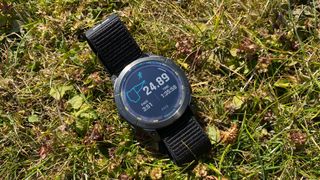
Given the price and adventurous target market of the original Enduro, the fact it didn’t offer maps was its biggest drawback. That’s been addressed with the Enduro 2, which comes with colour maps and all of Garmin’s exceptional navigation features.
Along with turn-by-turn directions, you receive helpful insights into the climbs and descents on your route through ClimbPro, as well as the Up Ahead feature – where you can mark the key points on your route, such as aid stations in ultra-marathons, and see the distance to them. An addition is NextFork, which shows you the details on the next fork in the trail you’re on, even when you are not using a pre-planned route.
No other brand on the market comes close to the mapping and navigation features of Garmin’s top watches, and they are a key addition to the Enduro 2.
GPS And HR Accuracy
Garmin’s multi-band tracking has been impressively reliable for me across the range of devices that offer it, though the Epix 2 stands out as the most accurate, outperforming the Fenix 7, Forerunner 955 and Enduro 2. We’re talking fine margins, though, and the Enduro 2 has been accurate during my runs and bike rides when in multi-band mode.
I also used SatIQ mode for a week, in which the watch automatically changes between GPS modes as required. In theory, this means it will save battery by using GPS-only in good GPS conditions and turn on the more accurate modes only when required. The GPS tracking I saw in this mode was accurate, but it threw up more mistakes than multi-band mode, and I didn’t see a noticeable improvement in battery life, so I turned multi-band back on.
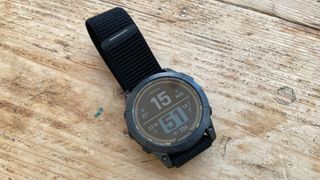
The heart rate tracking accuracy has been less impressive on the Enduro 2 and falls in line with what I would expect from an optical HR monitor worn at the wrist. On easy runs it was generally fine, matching up with a chest strap’s readings, but with harder progression runs or interval sessions the optical heart rate tracking lagged, or would read incorrectly for a short period. This is enough to skew the training analysis offered by the watch, and I recommend pairing it with an external chest strap for more reliable readings.
Sports Tracking And Training Analysis
The Enduro 2 has all of Garmin’s best sports tracking and training analysis features, with the most notable additions to the watch being grade-adjusted pace (GAP) and training readiness.
I have used GAP on Coros watches before and in Strava, and it is a useful stat that helps ensure you don’t overdo uphills on easy runs or relax too much on downhills during hard runs. I think it would be more useful still if the watch showed average GAP for your run, or lap GAP, to help you keep your effort even over undulating terrain because current GAP, like all current pace stats, can be erratic.
It’s also limited because it can’t take terrain into account: a hard climb on muddy ground or a steep descent on technical, loose trails would be different to running the same incline on a flat, good surface.
Training readiness first arrived on Garmin’s range with the Forerunner 955 and is now available on the Epix 2 and Fenix 7 as well as the Enduro 2. It’s a one-stop shop of a stat, giving you a colour-coded rating of your readiness to train based on a number of factors that are shown within the readiness widget. These include your recent sleep, training load and recovery time heart rate variability (HRV) status – another recent addition to Garmin’s range, measured at night. It’s not a perfect stat, since Garmin’s sleep tracking can be generous, but it is a useful one in my experience, especially since similar measurements from devices like Oura and Fitbit aren’t as good at taking into account your training load.
The sports tracking and training analysis on the Enduro 2 is superb overall, but you do get the same experience on cheaper watches like the Forerunner 955 and Fenix 7.
Music And Smart Features
Music was the other big omission from the original Enduro, and while it’s a less essential addition to the Enduro 2 in my opinion, it’s nice to be able to store and play music on the watch. You can link it up with streaming services like Spotify if you have a premium account, and it’s easy to transfer music to the watch wirelessly and link up a set of Bluetooth headphones. Just be aware that playing music is taxing even for the battery life of the Enduro 2.
Other smart features include Garmin Pay – still poorly served by the UK’s major banks – plus the usual notifications and calendar support. The Enduro 2 has access to the Connect IQ app store, which has a handful of useful apps and a load of other watch faces to pick from.
This is the best of Garmin’s smart features, but those who want more of a smartwatch look will find it in the Epix 2, which has an AMOLED screen that is brighter than the transflective display on the Enduro 2.
Activity And Sleep Tracking
The Enduro 2 will track your every move throughout the day and night, logging steps, floors climbed, calories burned and intensity minutes. The step target can be set to change in line with your activity, though Enduro 2 users will surely be more concerned with distance run and mountains climbed than steps taken.
Garmin’s sleep tracking has long underwhelmed me. The brand’s watches consistently overestimate my time asleep by logging any time where I’m fairly still past 10pm as light sleep, when I might well have been reading or watching TV.
Things are improving on this front. The Enduro 2 and other devices I’ve tested recently have got the time I fell asleep right more frequently, and the sleep tracking has been good enough on the watch to support the readiness feature, which is the key for me since I’m mainly interested in my sleep in relation to how fit I am to train well.
Is The Garmin Enduro 2 Worth It?
The decision over whether to buy the Enduro 2 is a simple one. Do you want the best Garmin features with the biggest battery life and don’t care about the cost? Then it’s the Enduro 2 for you.
There is better value in the Fenix 7 range, where impressive battery life is still on offer – in particular with the Forerunner 955, which costs $499.99/£479.99. It has all the same key features and still lasts a week on a charge.
The other option is the Garmin Epix 2, which has a shorter battery life but a better screen than the Enduro 2, and this comes to the fore when running under tree cover or using the maps on the watch. The Epix 2 is expensive, too, but unless you need that huge battery life for multi-day or ultra-distance activities, or just really hate looking for your charger, it offers a more enjoyable day-to-day experience because of the AMOLED display.

Nick Harris-Fry is a journalist who has been covering health and fitness since 2015. Nick is an avid runner, covering 70-110km a week, which gives him ample opportunity to test a wide range of running shoes and running gear. He is also the chief tester for fitness trackers and running watches, treadmills and exercise bikes, and workout headphones.

Coros Vertix 2S Review: The Garmin Fenix Rival Gets Some Useful Upgrades

I Tried CrossFit Champ Mat Fraser’s Signature 40-Minute EMOM And It Helped Me Build Strength, Skill And Endurance In One Fell Swoop

I Took A Test To Find Out If I Had What It Takes To Be An Elite Athlete And It’s Changed My Training For The Better
